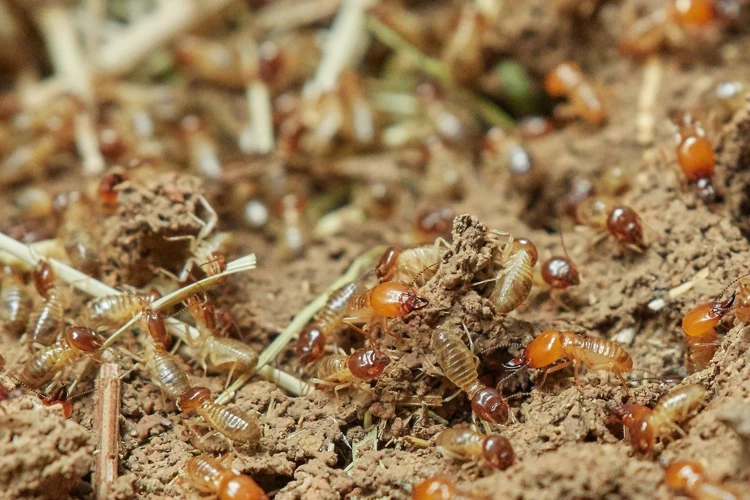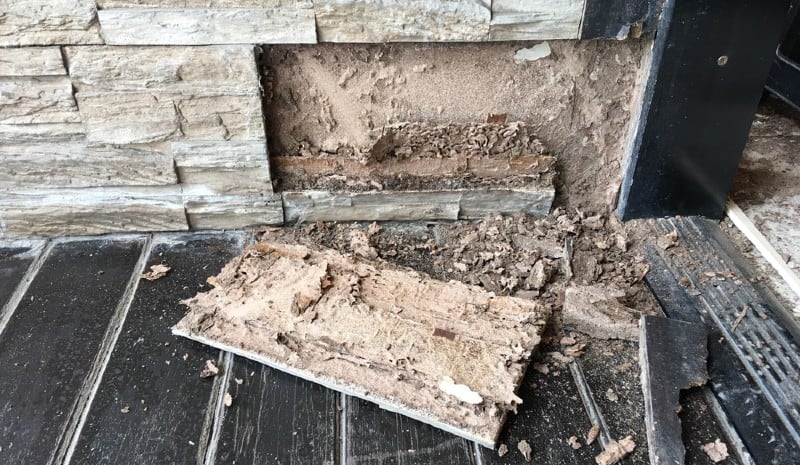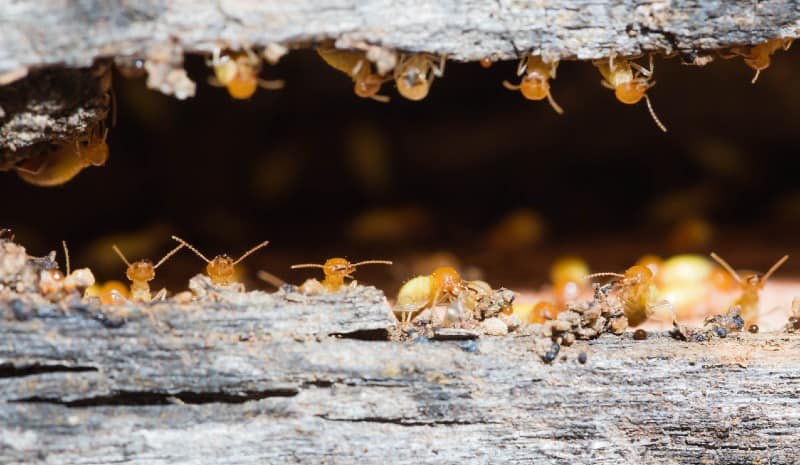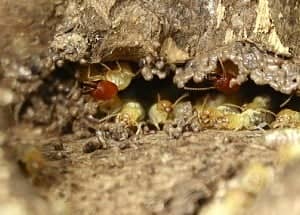What Are Termites?

Termites are notorious pests that homeowners and property owners often encounter. They are tiny insects that feed on wood, paper, and other cellulose materials. Despite their small size, termites can cause significant damage to properties if left unchecked. Understanding the lifecycle of termites and the factors affecting termite lifespan is crucial in preventing termite infestations. In this section, we will explore the anatomy of termites, termite colonies, and the termite lifecycle, including the egg stage, nymph stage, and adult stage.
Then, we will dive into the different factors that affect termite lifespan and how those factors influence the complete termite life cycle. So, let’s take a closer look at termites to understand how to prevent termite infestations in your home or property. Don’t forget to check out our article on the complete termite life cycle for more information.
Anatomy of Termites
Termites are tiny insects that belong to the order Blattodea. They are eusocial insects that live in large colonies and feed on cellulose-containing materials like wood and plant debris. The anatomy of termites is well adapted to their social behavior and feeding habits. Let’s take a closer look at the different body parts of termites.
Head: The head of a termite is relatively small and features a pair of mandibles that are used for biting and chewing on wood. The mandibles are also used for defense against predators. Termites have a pair of compound eyes that help them perceive light and dark, as well as simple eyes (ocelli) that help them detect the intensity and direction of light.
Thorax: The thorax of a termite is divided into three segments and bears six legs. The legs are relatively short and are adapted for walking rather than jumping or running.
Abdomen: The abdomen of a termite is elongated and segmented. It contains the digestive system, reproductive system, and respiratory system of the insect. The gut of a termite contains symbiotic protozoa and bacteria that help break down the cellulose in wood and other plant materials.
Wings: Winged termites (also called alates) have two pairs of wings that are equal in size and shape. The wings are shed after mating and can often be found around windows and other light sources. The presence of wings can be a sign of termite infestation.
Termites have a unique and complex social structure that allows them to live in large colonies and exploit a wide variety of food sources. The anatomy of termites is highly adapted to their social behavior and feeding habits. To learn more about the different stages in the termite life cycle, click here. If you’re curious about the lifespan of termites, click here. And to learn more about the different stages of termite infestation, click here.
Factors Affecting Termite Life Cycle
The life cycle of termites is influenced by various factors, both internal and external. Here are some of the factors that have a direct impact on the life cycle of termites:
| Factor | Description |
|---|---|
| Temperature | The temperature of the surrounding environment plays a critical role in the life cycle of termites. If the temperature is too low, the growth and development of termites slow down, while higher temperatures can speed up their growth and development. Termites tend to thrive in temperatures between 75-95°F. |
| Humidity | Similarly, humidity levels affect the life cycle of termites. Higher levels of humidity facilitate molting and the growth of termites, while lower humidity levels result in their slow growth and development. |
| Food Availability | The availability of food is crucial for the growth and development of termites. Without adequate food, their growth is stunted, and they may even die. Availability of food resources also affects the rate of survival and reproduction of termites. |
| Predators | Termites have a range of predators that can impact their life cycle. Natural predators like ants, birds, and spiders can reduce the number of termites in an area, while man-made predators such as pesticides and insecticides can also impact their population. |
| Genetic Factors | The genetic makeup of termites can also impact their life cycle. Certain species of termites may adapt and evolve to their surroundings, allowing them to survive and thrive in adverse conditions. |
| Location | The location of termite colonies can also affect their life cycle. Termite colonies situated in moist and humid areas may have a longer lifespan, while those in dry and arid regions may struggle to survive. |
It is crucial to understand these factors as they can help to prevent and control termite infestations.
Effects of Weather on Termite Life Cycle
The life cycle of termites is greatly affected by various environmental factors, including weather conditions. Changes in temperature, humidity, and rainfall can have a significant impact on termite populations and their behavior. Here’s a table that summarises the effects of weather on termite life cycle:
| Weather Condition | Effect on Termites |
|---|---|
| Dry and Hot | Termites will dig deeper into the soil to find moisture, making them less active and reducing their ability to cause damage to wooden structures. However, established colonies with access to moisture will still thrive. |
| Wet and Humid | Termites will be more active, as the moisture in the air and soil makes it easier for them to move around and find sources of food. This increases the risk of termite infestation and damage to wooden structures. |
| Frosty or Freezing | Termites will be less active and may not be able to survive extreme cold temperatures. However, subterranean termites are able to construct protective tunnels and maintain warmth within their colonies, allowing them to survive the winter. |
| Windy | Strong winds can disrupt termite foraging and feeding activities. Termites may also be unable to build protective tunnels against strong winds, leaving their colonies vulnerable to predators and the elements. |
It’s important to note that while weather conditions can affect termite behavior and populations, they are not the only factors to consider. Other environmental factors, such as soil type and moisture content, also play a crucial role in the life cycle and behavior of termites.
Preventing Termite Infestation
Termites are not only a nuisance but also cause a significant amount of damage to properties. Prevention is the key to ensuring that termites do not infest your home or office. Taking the necessary steps to prevent an infestation is a crucial part of protecting your property from severe damage. In this section, we will explore some effective techniques and methods to prevent termite infestation. By implementing these techniques, you can save yourself from the stress, headache, and expenses that come with a termite infestation.
Pre-Construction Treatment
One effective way to prevent termite infestation in your home is through pre-construction treatment. This treatment involves creating a barrier between the soil and the foundation of the building before construction begins. Here are some pre-construction treatments that can be used to prevent termite infestations:
- Chemical Barriers: Chemical barriers are created by applying liquid termiticides to the soil around the foundation of the building. This creates a barrier that prevents termites from entering the building through the soil. The chemicals used can last for up to ten years and are one of the most effective ways of preventing termite infestations.
- Baiting Systems: Baiting systems involve placing termite bait stations in the soil around the foundation of the building. The bait stations contain a substance that is toxic to termites. When termites consume the bait, they carry it back to the colony, where it can eliminate the entire colony. This method is environmentally friendly and is effective in controlling termite infestations.
- Physical Barriers: Physical barriers are made by installing metal mesh or crushed rocks between the soil and the foundation of the building. These barriers prevent termites from entering the building through the soil. This method is less effective than chemical or baiting systems but is still useful in preventing termite infestations.
It is important to note that pre-construction treatments should only be carried out by professionals who have experience in termite control. The effectiveness of the treatment largely depends on the correct installation and application of the barrier. It’s essential to hire experts in termite prevention to ensure proper installation. By using pre-construction treatments, you can significantly reduce the risk of termite infestation in your home or building.
Post-Construction Treatment

After the termite treatment in the pre-construction phase, post-construction treatment plays a crucial role in preventing termite infestation. Post-construction treatments are necessary in buildings that were not treated during their construction stage or already face termite infestation. This treatment helps in creating a barrier for termites by using different chemicals or mechanical methods.
Chemical Treatment: One of the most common and effective post-construction treatments is a chemical treatment. Professionals apply liquid termiticides to the soil around the foundation of the house to prevent termite infestation. This treatment creates a chemical barrier preventing termites from entering the house from the ground.
Baiting System: Another effective post-construction treatment is a termite baiting system. This system uses different bait stations that contain a slow-acting termiticide. The termites carry the bait inside their colony, which eventually spreads to other termites, killing them.
Wood Treatment: Wood treatment is another method of post-construction treatment that involves applying a wood preservative chemical to wood elements of the house. This treatment also acts as a barrier against termites and helps protect the wood from further termite damage.
Physical Barrier: Physical barriers are another way to prevent termite infestation in post-construction. A stainless-steel mesh barrier is installed around the foundation of the house, preventing termites from entering through small cracks or openings.
To ensure that the post-construction treatment is effective, it is essential to hire a professional pest control company. They have the expertise and right equipment to apply the treatment correctly. Homeowners should regularly inspect their homes to detect any signs of termite infestation. Taking preventive measures and promptly addressing any termite activity can help protect the house from significant termite damage.
A table summarizing different types of post-construction treatments:
| Treatment Method | Description |
|---|---|
| Chemical Treatment | Application of a liquid termiticide around the foundation of the house acting as a chemical barrier |
| Baiting System | Installation of bait stations containing slow-acting termiticides that eventually spread to the entire colony through termites |
| Wood Treatment | Application of a wood preservative chemical protecting the wood from termites and preventing further termite damage |
| Physical Barrier | Installation of a stainless-steel mesh barrier around the foundation, preventing termites from entering through small cracks or openings |
Elimination of Moist and Dampness
Moist and damp conditions provide an ideal environment for termites to thrive and grow. The elimination of moisture is an essential step in termite control and prevention. Here are some effective ways to eliminate moisture and dampness:
| Methods | Explanation |
|---|---|
| Repair Leaks | Leaking pipes and faucets should be repaired to ensure that the area around them stays dry. Even small leaks can lead to the growth of mold and mildew, which attract termites. |
| Improve Ventilation | Poor ventilation in homes and buildings can cause condensation, which creates a damp environment. Proper ventilation can help to reduce this problem. |
| Clean Gutters and Downspouts | Clogged gutters and downspouts can cause water to accumulate around the foundation of your home or building. Cleaning them regularly will ensure that rainwater is directed away from the structure. |
| Use a Dehumidifier | A dehumidifier can be used to reduce the humidity levels in your home or building. By removing excess moisture from the air, termites will be less likely to establish themselves. |
| Avoid Excessive Watering | Excessive watering of plants and lawns can cause the soil around your home or building to become saturated, creating a damp environment. Watering should be done in moderation. |
By implementing these moisture elimination methods, you can prevent termites from finding a suitable environment in your home or building. Remember that prevention is always better than cure, so it is important to take termite control seriously to avoid costly damages in the future.
Conclusion
By understanding the life cycle of termites and the factors that affect it, we can take steps to prevent termite infestations and protect our homes from damage. From regular inspections to moisture control, there are a number of preventative measures we can take.
It’s important to remember that prevention is key when it comes to termite infestations. Whether you’re building a new home or have been living in the same house for years, taking steps to prevent termites from entering and colonizing your property is essential.
By using pre- and post-construction treatments, termite barriers, and maintaining a dry environment, you can greatly reduce the risk of a termite infestation. Regular inspections conducted by a professional will also help catch any potential problems before they turn into major damage.
Overall, understanding the life cycle of termites and the steps we can take to prevent them from infesting our homes is important for any homeowner. By taking a proactive approach and implementing preventative measures, you can protect your property and avoid costly damage from these destructive pests.

Frequently Asked Questions
What is the life span of a termite?
The life span of a termite varies depending on the termite’s role in the colony, with workers living for around two years and the queen living for over a decade.
Do termites only eat wood?
Contrary to popular belief, termites do not only eat wood. They are also known to feed on cellulose materials such as paper, cardboard, and some fabrics.
How do you know if your house has a termite problem?
Signs of a termite problem include mud tubes on walls and foundations, discarded wings, hollow wood, and visible termite damage on wood and other cellulose materials.
Can termites cause damage to concrete foundations?
While termites cannot directly damage concrete foundations, they can build mud tubes on concrete to reach wood or other cellulose materials, causing damage to those structures.
Do termites hibernate during cold weather months?
Termites do not hibernate during cold weather months, but they may slow down their activity levels due to changes in temperature and humidity.
Do all termite species live in colonies?
Yes, all termite species live in colonies to some extent. Some species have smaller colonies while others have larger colonies with hundreds of thousands of individual termites.
Can termites be harmful to humans?
Termites are not directly harmful to humans, but they can cause significant damage to structures and buildings, leading to expensive repairs and potential safety hazards.
Can termites fly?
Yes, some termite species have wings and can fly. These termites are often referred to as swarmers and are the reproductive individuals in the colony.
What should I do if I find termites in my home?
If you find termites in your home, it’s important to contact a pest control professional immediately to assess the extent of the infestation and develop a treatment plan.
What are some natural ways to prevent a termite infestation?
Some natural ways to prevent a termite infestation include using cedar and other naturally termite-resistant woods in building construction, eliminating sources of excess moisture, and regularly inspecting your home for signs of termite activity.

